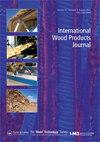Effect of glueline treatment using tobacco stalk and leaf midrib additives on the bond strength and termite resistance of urea-formaldehyde bonded plywood
IF 0.9
Q2 MATERIALS SCIENCE, PAPER & WOOD
引用次数: 1
Abstract
ABSTRACT Stalk and leaf midrib particles with size <74 µm from the native (Batek) tobacco (Nicotiana tabacum) were used as an additive to replace wheat and coconut shell flour in urea-formaldehyde adhesive formulations. Control and formulated glue-mixes with tobacco particles additive were used to bond Falcataria moluccana veneers into 3-ply plywood. The effect of varying amounts of tobacco particles (4, 8 and 12%) in the glue-mixes on shear strength, wood failure and subterranean termite (Microcerotermes losbañosensis) resistance of the plywood was examined. An increase in shear strength and wood failure up to 8% tobacco particles loading was observed compared with plywood that used commercial glue formulation. Based on shear strength and wood failure, panels containing 4–8% tobacco particles would pass the requirements of PNS ISO 12466-2. Termite resistance at 12% tobacco particles improved by 43% compared with the control. Thus, tobacco particles can be considered as a more beneficial alternative glue-mix additive in plywood production.用烟草秸秆和叶中脉添加剂进行胶粘处理对脲醛胶合板粘结强度和抗白蚁性能的影响
以巴泰克(Nicotiana tabacum)原生烟草(Nicotiana tabacum)中粒径<74µm的茎叶和叶中叶颗粒为添加剂,替代小麦粉和椰子壳粉用于脲醛胶粘剂配方。采用烟草颗粒添加剂控制和配制的胶料,将黄菖蒲贴面粘合成三层胶合板。研究了混合胶中不同烟草颗粒含量(4、8、12%)对胶合板抗剪强度、木材破坏和抗地下白蚁(Microcerotermes losbañosensis)性能的影响。与使用商业胶水配方的胶合板相比,抗剪强度和木材破坏增加了8%,烟草颗粒加载。基于抗剪强度和木材破坏,含有4-8%烟草颗粒的板材将通过PNS ISO 12466-2的要求。烟草颗粒浓度为12%时,抗白蚁能力较对照提高43%。因此,烟草颗粒可以被认为是胶合板生产中更有益的替代胶混合添加剂。
本文章由计算机程序翻译,如有差异,请以英文原文为准。
求助全文
约1分钟内获得全文
求助全文
来源期刊

International Wood Products Journal
MATERIALS SCIENCE, PAPER & WOOD-
CiteScore
2.40
自引率
0.00%
发文量
27
 求助内容:
求助内容: 应助结果提醒方式:
应助结果提醒方式:


